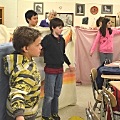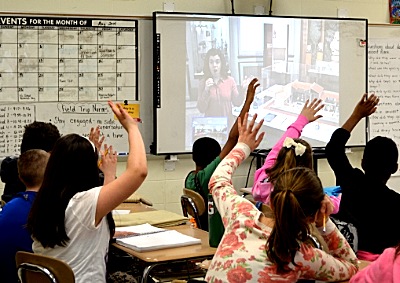- By Mary Grainger
- Around Town
 Print
Print  Boynton Middle School Social Studies teacher Kristin Herman couldn’t take her sixth grade students to University of Pennsylvania Museum of Archaeology and Anthropology, so she brought the museum to them.
Boynton Middle School Social Studies teacher Kristin Herman couldn’t take her sixth grade students to University of Pennsylvania Museum of Archaeology and Anthropology, so she brought the museum to them. With the help of an Ithaca Public Education Initiative (IPEI) Red and Gold Grant, Herman’s classes took a virtual field trip to the Penn Museum where they learned about the daily life and culture of ancient Romans. IPEI Red and Gold Grants are awarded to teachers, administrators, students and community members for projects that strengthen and enrich Ithaca schools.
“The idea for a virtual field trip came from the personal experiences I've had with Google Hangout and Skype,” Herman said. “With these platforms and others like them, communication across large distances becomes manageable. I looked for virtual venues that would enhance the curriculum in ways I couldn't provide because of lack of time, resources or expertise.”
This May Herman’s classes participated in an interactive video conference with a docent from the Penn Museum, who guided students through the Rome Gallery to examine materials that were a part of the daily life of elite Romans. The presentation included a virtual tour of an ancient Roman home and discussion about geographic and environmental characteristics of the time period and their effect on history. An up-close document camera allowed students to explore artifacts such as mosaic tiles, clay lamps, a loose-leaf tea strainer, and a wax tablet and stylus.

“It's always important to bring artifacts into the classroom or provide real-world experiences whenever possible, especially when teaching history,” Herman said. “The Penn Museum distance learning program provided a way to supplement what we are studying by virtually interacting with artifacts from daily life in ancient Rome.”
Throughout the presentation, which followed the classes’ study this spring of the development of the Roman Republic and Empire, students were invited to ask and answer questions, tying their knowledge of Roman history to modern times. For example, students learned how Roman portrait sculptures indicate age of family members, just as photographs do today. At the end of the session, students were led in how to properly tie a toga.
“They were familiar with the basic ideas, beliefs and traditions that have contributed to the modern world,” Herman said. “By seeing how a Roman townhouse was set up, some of the games children played, and tools used by ordinary citizens; students cemented their learning and made connections they may not have normally made with classroom activities alone.”
“What a terrific sharing of resources for our students and a good lesson in the positive impact technology can have in our classrooms,” said IPEI President Terry Byrnes, who attended one of the presentations. “I was impressed that this virtual field trip included lessons in geography, mathematics, archeology, science, vocabulary and history - all in one session.”
“My goal is to provide as many rich learning experiences as possible,” Herman said. “I couldn't take all my students to the Penn Museum so I am grateful to IPEI for helping me bring the museum to them.”
v10i18



